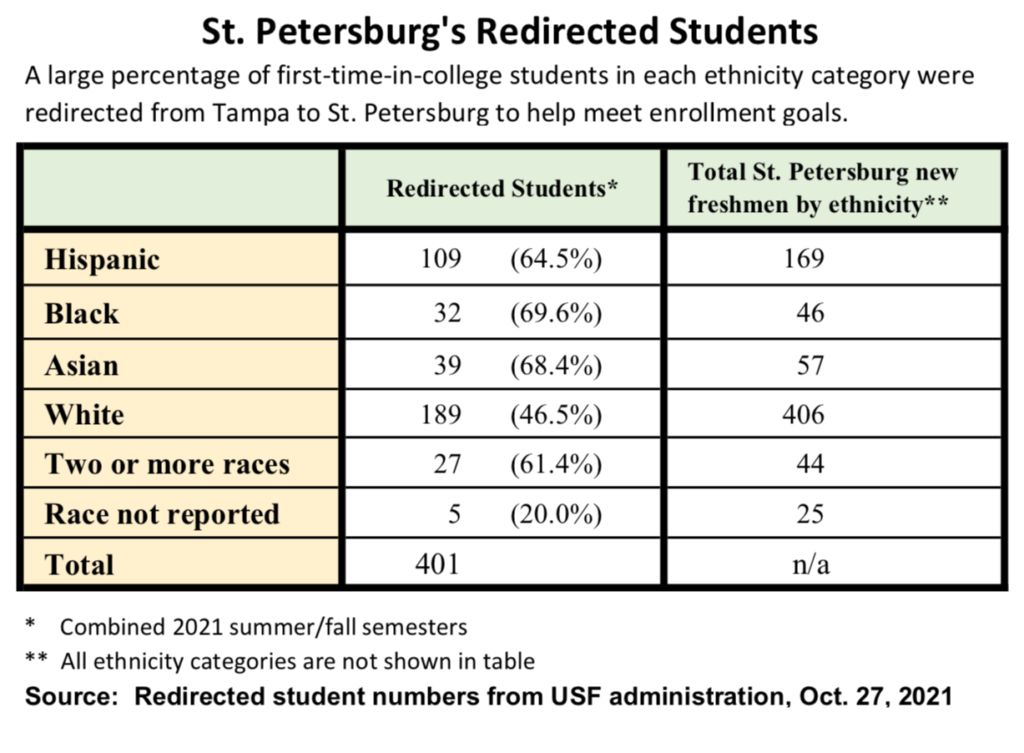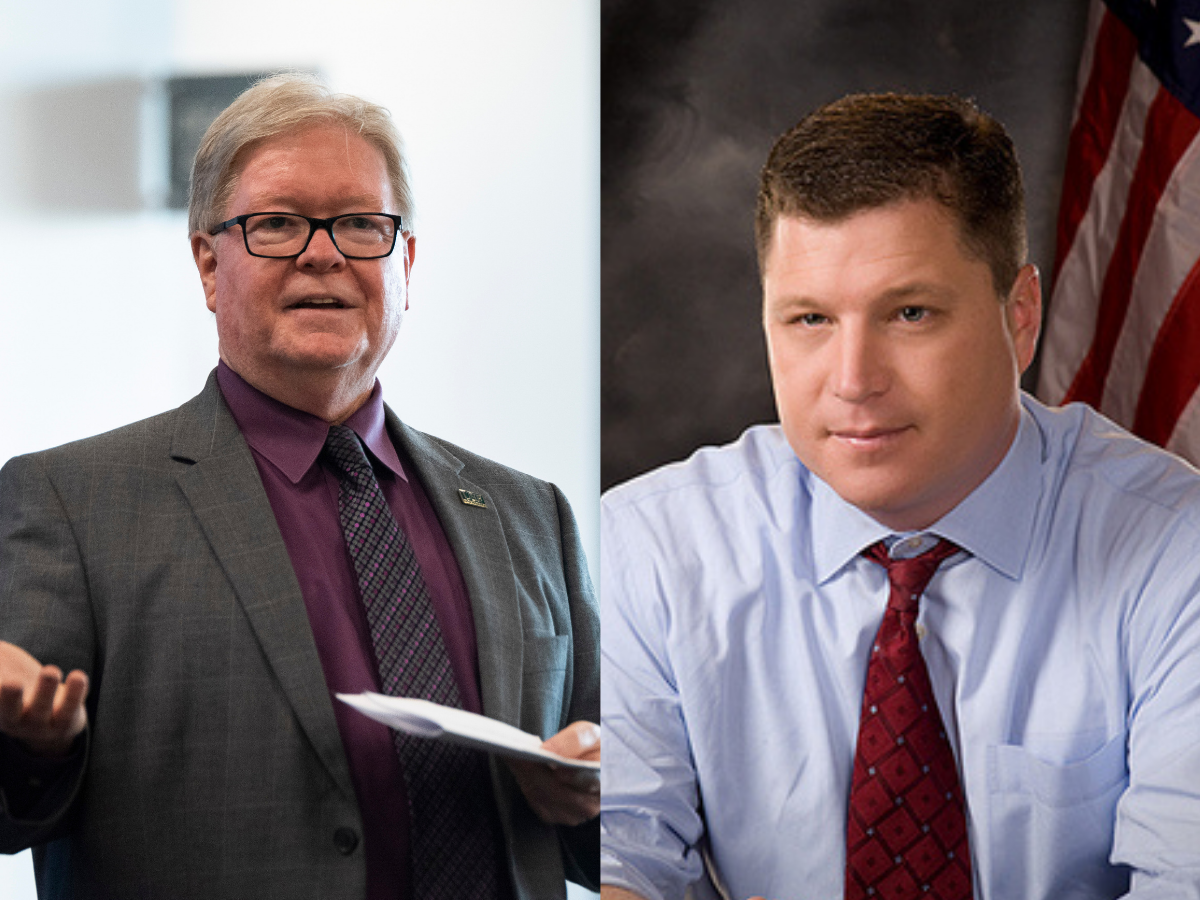Pictured above: Although many of St. Petersburg’s first time-in-college freshmen were redirected from the Tampa campus, Regional Chancellor Martin Tadlock (left) and State Sen. Jeff Brandes predict that broadened opportunities will make St. Pete a more attractive option in the future.
Courtesy of USF and Jeff Brandes
By Nancy McCann
At first glance, the combined summer and fall enrollment figures at USF St. Petersburg this year appear to be cause for celebration.
The number of first-time-in-college (FTIC) students rose from 420 last year to 756 – a whopping increase of 80%.
The number of new transfer students climbed from 510 to 592, up 16%.
And the number of Hispanic, Black and Asian new freshmen, when added together, almost doubled, going from 132 to 272.
A look inside the numbers, however, suggests it may be premature to pop the Champagne corks just yet.
** While the diversity and overall enrollment pictures are better, there are fewer new Black students this year than there were in 2017.
** While the number of new transfer students rose between 2020 and 2021, this year’s number is still 24% lower than the total in 2019.
** And while the number of first-time-in-college students soared, more than half of those 756 freshmen had originally selected Tampa as their home campus. They were redirected to St. Petersburg as USF admissions officials labored to pull up St. Petersburg’s badly sagging enrollment.
But will they stay?
The redirected students can go back to designating Tampa as their home campus starting in the 2022 spring semester, said USF spokesperson Althea Johnson.
That means, come January, the smaller campus’ sparkling enrollment jump might lose some luster.
Regional Chancellor Martin Tadlock said he is “not as concerned about that as some people might think.”
He said he sees several opportunities developing for bringing programs and students to the St. Petersburg campus.
“I’m really excited about the future enrollment of students on this campus,” said Tadlock. “We’re working with deans who really see and recognize the growth happening in St. Petersburg.”
State Sen. Jeff Brandes, R-St. Petersburg, who’s been a key player in consolidation of the three USF campuses and a critic of the way the university administration has handled it, said he’s satisfied with the way freshman enrollment is going at USF St. Petersburg — for now.
“I feel in the short term they met the goal [650 new freshmen in 2021],” Brandes said. “The question is: Can they do it over the long term and have students stay on campus? Are they committed to deploying the resources between the Legislature and the colleges and the university itself to make that temporary change permanent?”
An alarming tailspin
When Brandes and the Legislature voted in 2018 to consolidate the three campuses of USF, they did more than abolish the independent accreditations of USF St. Petersburg and USF Sarasota-Manatee.
They also sent St. Petersburg’s enrollment numbers into an alarming tailspin.
As the campus began rapidly raising its admission standards to align with Tampa’s in preparation for consolidation, the number of summer and fall new freshmen in St. Petersburg plummeted. It hit 420 in 2020 — down from 653 in 2017.
Pinellas legislators reacted by putting pressure on the USF administration to enroll 650 new freshmen at USF St. Petersburg for the 2021 combined summer and fall semesters.
To meet that target, the university’s admissions requirements were “flexed” because of the pandemic to admit some students who normally would not be admitted, USF Dean of Admissions Glen Besterfield said earlier this year, and hundreds of applicants were redirected to St. Petersburg.
Of the 756 FTIC students this summer and fall, more than half – 401 – were steered from Tampa to St. Petersburg.
Tadlock said he “certainly” wants the three residence halls filled and hopes the redirected students will stay but “won’t spend time on those technicalities.”
“I think our campus is an incredible opportunity for all students regardless of their designated home campus status,” Tadlock said. “So I don’t want to get caught up in . . . where a student has their home campus or where they’re taking a course. We just want to make sure that we continue to be an incredible place for those students regardless of their home campus.”
Johnson explained some of those technicalities in an email to The Crow’s Nest.
“Students are permitted to live wherever they would like, regardless of their home campus,” Johnson wrote. “They are welcome to live on the St. Petersburg campus and take classes at either the Sarasota-Manatee or Tampa campuses. Or they can apply for housing on the Tampa campus if they prefer.”
But if any of St. Petersburg’s students change majors to one not offered there, “they would need to change their home campus,” she wrote.
Brandes, like Tadlock, said he is focused on building programs that are best for attracting students to the St. Petersburg campus to reverse downward enrollment trends over the long term.
“The breadth of programs that Tampa offers will never be able to be offered in St. Petersburg,” Brandes said. “But we can tailor and have specific programs that are in high demand.”
“There’s an extreme nursing shortage in Florida,” Brandes said. “While USF Tampa has the medical school, I’m going to be pushing for St. Petersburg to have a significant investment in nursing.”
He said he’s also working on another program related to “risk management” and the Kate Tiedemann School of Business and Finance.
Another investment expected to uplift the St. Petersburg campus — if funded — is an $80 million Oceanographic & Environmental Sciences Research & Teaching Facility at the College of Marine Science.
Interim USF President Rhea Law told the USF St. Petersburg Campus Board on Oct. 14 that the research and teaching facility is the “number one” priority on the list of requested capital projects for the entire university.
“It is a transformational project,” she said.

‘Still not satisfied’
The number of minority students among this year’s incoming freshmen in St. Petersburg appears encouraging.
Compared to 2020, there are large increases. The number of first-time-in-college Hispanic students jumped from 90 to 169. The number of new Black freshmen rose from 18 to 46, Asian from 24 to 57.
But like the upswing in the total enrollment figure for the campus’ new freshmen, a significant percentage of this year’s new minority students were redirected from Tampa — meaning they did not originally choose St. Petersburg as their home campus (see table on redirected students).
Redirected Hispanic, Black and Asian students made up 66% of St. Petersburg’s total new freshmen in those three ethnicity categories for the combined 2021 summer/fall semesters.
And there’s more to consider when looking at the number of Black first-time-in-college students.
Since 2017, the percentage of the campus’ new Black students out of all incoming freshmen has dropped from about 8 to 6%. That number hit a low of 3% in 2019.
Only one new Black freshman enrolled at the St. Petersburg campus last fall, according to the university’s data. The combined 2020 summer/fall number for Black incoming freshmen was 18, down from 32 in 2018.
The Black population in the city of St. Petersburg is 22% of the total residents, according to U.S. Census Bureau QuickFacts. It’s 11.1% in Pinellas County, 16.9% in Florida and 13.4% in the United States.
Although the St. Petersburg community and some of its elected officials have been concerned about the campus’ minority student numbers and there have been numerous diversity initiatives, Tadlock said there hasn’t been enough progress.
“I’m still not satisfied with where we are [in the area of diversity and inclusion],” said Tadlock. “I feel much better about it than I did last year. But I’m not satisfied yet.
“We’ve got the Pinellas Access to Higher Education (PATHe) program with some dynamic people working in the high schools in Pinellas County to encourage those students to come to our campus.”
Tadlock also mentioned the Truth, Racial Healing and Transformation (TRHT) Campus Center and associated fellowships for students to work with the center.
“To be honest, students want to go to school where they find students who look like them in most cases,” Tadlock said. “And we just simply don’t have that number of students yet — where you can walk on the campus and feel that we are as diverse as we should be.”

The drop in transfers
When St. Petersburg’s incoming freshman enrollment plummeted after admissions standards were raised to prepare for consolidation, university administrators said students who didn’t get accepted could have another path to the university.
The administration had a mantra: Entering as a transfer student was a good alternate gateway to USF.
But from 2019 to 2020, the number of new transfer students in the combined summer/fall semesters fell from 779 to 510. It came up a bit this year to 592.
Johnson, the USF spokesperson, said “it is difficult to quantify the drop in transfer students at the St. Petersburg campus.”
“One factor includes a more robust requirement established by academic colleges,” Johnson wrote to The Crow’s Nest. “The drop in enrollment at St. Petersburg College, the main feeder to the USF St. Petersburg campus, is also a contributing factor.”
When asked if transfer student numbers are expected to rebound to the 2019 figure, Johnson said “that is unknown at this time.”
When Tadlock was asked if it’s a problem to have higher freshman admissions standards — making it more difficult to attend USF St. Petersburg — with fewer transfer students than anticipated, he said he thinks the campus’ enrollments “are going to be fine.”
He said in addition to having strong programs that build relationships with St. Petersburg College, Hillsborough Community College and other two-year institutions, “we are entering conversations with St. Pete College to allow its students to live and take classes on the [USF] St. Pete campus.”
Tadlock said he wants to remain focused on what the campus has to offer students and give them choices “for what’s right for them.”
“Every year for the next several years, you’re going to see new degree programs being offered on our campus that we haven’t been able to offer in the past so more students can participate in that major,” he said.
For Brandes, it can all be tied back to programs, whether the subject is new freshmen, minority students or transfer students.
“There’s a strong correlation between the type of programs you offer and the students that you get,” Brandes said. “So, the question is: Can we tailor our offerings to the demographics which we’re trying to acquire?
“We can’t roll out every program at one time. The campus is going to naturally evolve. Even if we have to sustain enrollment for the summer and fall semesters for a few years [by redirecting students from Tampa] to essentially prime the pump, I fully believe USF St. Petersburg will exceed every target we’ve ever seen.”



